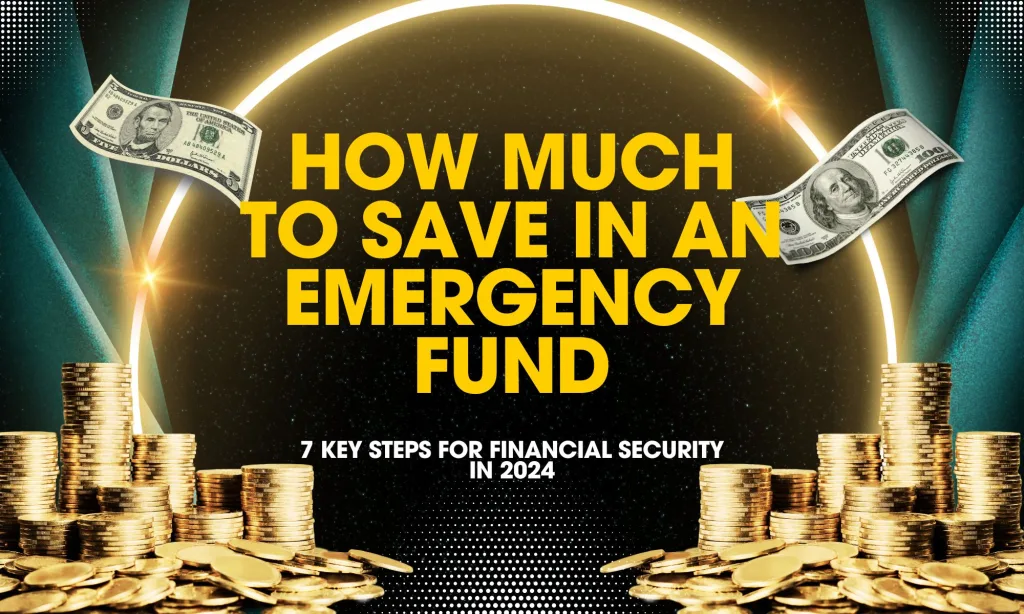How Much To Save In An Emergency Fund: 7 Key Steps For Financial Security In 2024
In today’s unpredictable financial landscape, knowing how much to save in an emergency fund is crucial. An emergency fund acts as a safety net, providing peace of mind and financial stability when unexpected expenses arise. This guide will walk you through the essentials of building an emergency fund, ensuring you’re well-prepared for whatever life throws your way.
Understanding the Purpose of an Emergency Fund
Before diving into how much to save, let’s clarify the purpose of an emergency fund. This fund is designed to cover unforeseen expenses, such as medical emergencies, car repairs, or job loss.
Why You Need an Emergency Fund
- Financial Security: Life is full of surprises. Having an emergency fund means you won’t have to rely on credit cards or loans when unexpected expenses arise.
- Peace of Mind: Knowing you have a financial cushion can significantly reduce stress. It allows you to focus on other aspects of your life without worrying about money.
- Avoiding Debt: An emergency fund can help you avoid accumulating debt during tough times. Instead of borrowing, you can dip into your savings.
- Flexibility: With an emergency fund, you can make decisions that align with your goals rather than being forced into choices based on financial pressure.
- Building Good Habits: Saving for emergencies encourages a habit of saving, which can lead to better financial health overall.
How Much to Save in an Emergency Fund

General Guidelines
The amount you should save in your emergency fund can vary based on your personal circumstances. A common rule of thumb is to save three to six months’ worth of living expenses.
Factors To Consider
- Monthly Expenses: Start by calculating your essential monthly expenses, including rent or mortgage, utilities, groceries, and transportation. This will give you a baseline for your emergency fund.
- Job Stability: If you have a stable job with a reliable income, you might lean towards the lower end of the three to six months’ guideline. However, if your job is less secure or if you’re in a volatile industry, consider saving more.
- Dependents: If you have children or other dependents, it’s wise to save more. Their needs can add financial pressure in emergencies, so a larger fund can provide extra security.
- Health Considerations: If you have ongoing medical expenses or health concerns, you may want to save more to cover potential medical emergencies.
- Lifestyle Choices: Your lifestyle can also influence how much you need to save. If you live in an area with a high cost of living, you might need a larger emergency fund.
Example Calculation
Let’s say your essential monthly expenses total $3,000. Using the three to six months’ guideline, you would aim to save between $9,000 and $18,000 in your emergency fund. This range provides a solid cushion for unexpected events.
Steps To Build Your Emergency Fund
1. Set a Savings Goal
Establish a clear savings goal based on your calculations. This goal will guide your saving efforts and keep you motivated. Write it down and keep it visible to remind yourself of your objective.
2. Create a Budget
To save effectively, create a budget that allocates a portion of your income specifically for your emergency fund.
- Identify Savings: Determine how much you can realistically save each month. Even small amounts add up over time.
- Cut Unnecessary Expenses: Review your budget for areas where you can cut back. Redirect these savings into your emergency fund.
3. Open a Separate Savings Account
Consider opening a high-yield savings account specifically for your emergency fund. This keeps your savings separate from your everyday spending and can earn interest over time.
4. Automate Your Savings
Set up automatic transfers from your checking account to your emergency fund. Automating your savings makes it easier to stick to your goal without having to think about it.
5. Monitor Your Progress
Regularly check your emergency fund balance. Celebrate milestones, whether it’s reaching the halfway mark or achieving your final goal. Monitoring your progress keeps you motivated.
6. Adjust as Necessary
Life changes, and so will your financial situation. If you experience a significant life event, such as a job change or a new family member, reassess your emergency fund goal and adjust accordingly.
7. Replenish After Use
If you ever need to dip into your emergency fund, make it a priority to replenish it as soon as possible. This ensures you’re always prepared for future emergencies.
Common Misconceptions About Emergency Funds
1. “I Don’t Need One If I Have Insurance”
While insurance can cover many unexpected expenses, it doesn’t cover everything. Deductibles, out-of-pocket costs, and non-covered expenses can still leave you financially vulnerable.
2. “I Can Just Use Credit Cards”
Relying on credit cards for emergencies can lead to debt. Interest rates can accumulate quickly, making it harder to pay off your balance. An emergency fund provides a better solution.
3. “I’ll Start Saving Later”
Procrastination can be tempting, but starting your emergency fund now is crucial. The sooner you begin saving, the sooner you’ll have a financial safety net.
Comments
Post a Comment